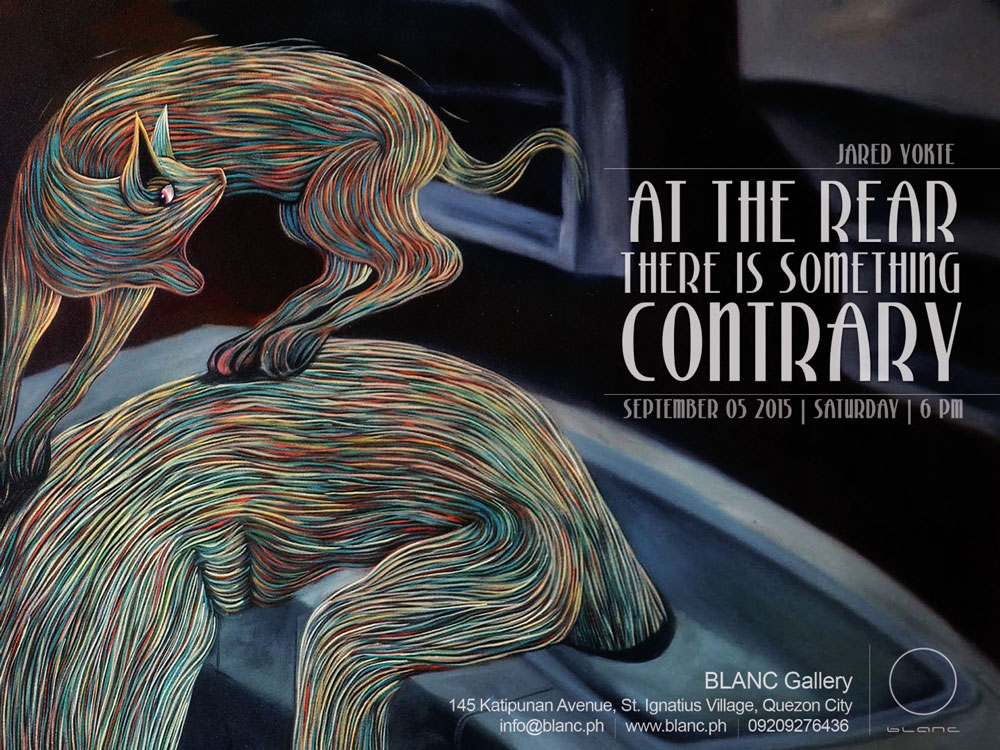
Jared Yokte picks up right where he left off in At the Rear There Is Something Contrary, an exhibition populated by boneless Chagall-like figures floating and tumbling in space. Stripped of their skin, humans and animals appear as bundles of rainbow-colored noodles bouncing around in houses exempt from the laws of gravity. The distinct look, described by artist critic Cid Reyes as “intricate, flowing striations of lines, like exposed musculature or twisting ropy old twine,” is derived from rubber-cut prints. Fascinated, Yokte applied the gouged-out effect (typical of linocut prints) to his oil paintings and never looked back.
At the Rear questions traditions, beliefs, and enculturation — themes Yokte has explored in his previous shows. The title refers to the niggling doubt that lives in the back of your mind, the better sex video free online little voice that gets louder in the dead of the night. Stilted in phrasing, At the Rear There Is Something Contrary is also an amusing pun on all the exposed derrieres in his canvases.
Yokte’s surreal paintings have a diluvial feel, most evident cialis good for heart in the title piece and in The Theory of Nonsense I. Bodies, sometimes headless, swim through dimly lit interiors and are pushed topsy turvy into the furniture by an unseen force. Dark brown sludge makes an almost audible splat as it hits vulnerable targets — an unprotected back, an exposed chest, a flailing limb. The presence mud, umbrellas, as well as of cats and dogs, nudge the brain into making the connection between Yokte’s turbulent composition and the floods that plague Tarlac, where he is based. Although born in Davao Oriental, Yokte now lives and gay and lesbian speed dating il works in the landlocked province that is a part of the Pampanga River Basin, an area that is usually inundated during the wet season.
For the artist, the chaos of levitating bodies and chairs caught in mid-flight is symbolic web cams rated of the world we live in. According to Yokte’s iconography, umbrellas are psychological portents and symbols of backward thinking; stray animals quarreling over the last scrap of leftover meat are signs of deteriorating society; and decapitation is literally showing that “your head and heart are not communicating properly or that one may be dominating the other.”
The kinetic movement of At the Rear There Is Something Contrary is also representative of a mind questioning the status quo. Like the bodies in his paintings, Yokte is buffeted this way and that by social institutions. “Our traditional way of living, our beliefs, how you were shaped by society — you’re forced into these things,” he said in the vernacular. He is against these repetitive and detrimental patterns of behavior, he added, which often begin at
viagra do you need a prescription home, hence his decision to situate all the works in this exhibition in a domestic scene.
While these are well-trod themes beloved by artists grappling with existential angst, Yokte separates himself through a signature style that belies his years. Once you see
a Yokte painting, with its striated human forms and dark palette, there is instant recognition. You will be able to pick out his work in a sea of others — no small feat when there are a great many artists striving to be noticed. — ll
WORKS
DOCUMENTATION















